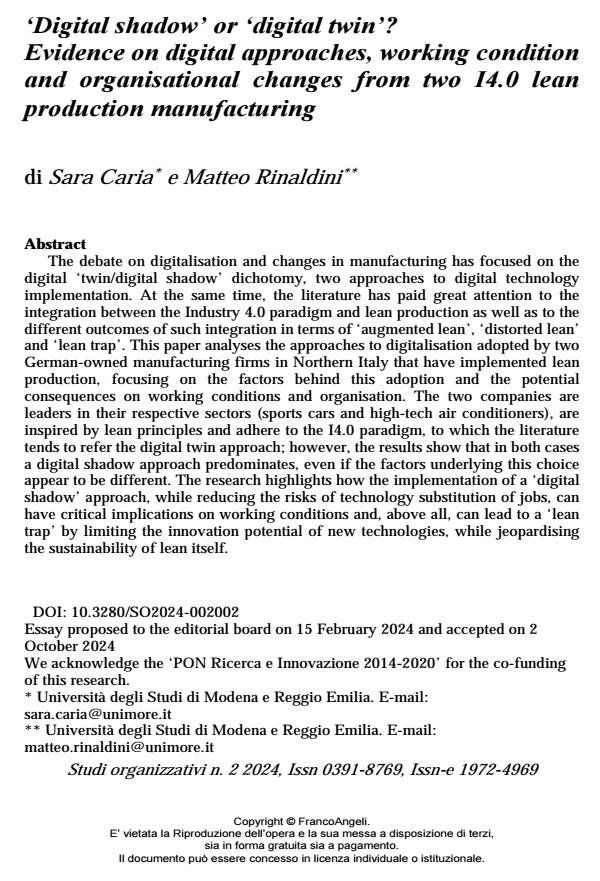‘Digital shadow’ or ‘digital twin’? Evidence on digital approaches, working condition and organisational changes from two I4.0 lean production manufacturing
Titolo Rivista STUDI ORGANIZZATIVI
Autori/Curatori Sara Caria, Matteo Rinaldini
Anno di pubblicazione 2025 Fascicolo 2024/2
Lingua Inglese Numero pagine 28 P. 11-38 Dimensione file 243 KB
DOI 10.3280/SO2024-002002
Il DOI è il codice a barre della proprietà intellettuale: per saperne di più
clicca qui
Qui sotto puoi vedere in anteprima la prima pagina di questo articolo.
Se questo articolo ti interessa, lo puoi acquistare (e scaricare in formato pdf) seguendo le facili indicazioni per acquistare il download credit. Acquista Download Credits per scaricare questo Articolo in formato PDF

FrancoAngeli è membro della Publishers International Linking Association, Inc (PILA)associazione indipendente e non profit per facilitare (attraverso i servizi tecnologici implementati da CrossRef.org) l’accesso degli studiosi ai contenuti digitali nelle pubblicazioni professionali e scientifiche
The debate on digitalisation and changes in manufacturing has focused on the digital ‘twin/digital shadow’ dichotomy, two approaches to digital technology implementation. At the same time, the literature has paid great attention to the integration between the Industry 4.0 paradigm and lean production as well as to the different outcomes of such integration in terms of ‘augmented lean’, ‘distorted lean’ and ‘lean trap’. This paper analyses the approaches to digitalisation adopted by two German-owned manufacturing firms in Northern Italy that have implemented lean production, focusing on the factors behind this adoption and the potential consequences on working conditions and organisation. The two companies are leaders in their respective sectors (sports cars and high-tech air conditioners), are inspired by lean principles and adhere to the I4.0 paradigm, to which the literature tends to refer the digital twin approach; however, the results show that in both cases a digital shadow approach predominates, even if the factors underlying this choice appear to be different. The research highlights how the implementation of a ‘digital shadow’ approach, while reducing the risks of technology substitution of jobs, can have critical implications on working conditions and, above all, can lead to a ‘lean trap’ by limiting the innovation potential of new technologies, while jeopardising the sustainability of lean itself.
Il dibattito su digitalizzazione e cambiamento della produzione manifatturiera si è focalizzato sulla dicotomia digital twin/digital shadow, due distinti approcci all’implementazione delle tecnologie digitali. Allo stesso tempo, la letteratura ha prestato grande attenzione all’integrazione tra il paradigma Industria 4.0 e lean production e ai diversi possibili esiti di tale integrazione in termini di augmented lean, distorted lean e lean trap. Il presente lavoro analizza gli approcci alla digitalizzazione adottati da due imprese manifatturiere tedesche nel Nord Italia che hanno implementato modelli di lean production, prestando particolare attenzione ai fattori alla base di tale adozione e alle potenziali conseguenze su condizioni di lavoro e organizzazione. Le due imprese, leader nei rispettivi settori (automobili sportive e condizionatori per ambienti high tech), si ispirano ai principi lean e aderiscono al paradigma I4.0, a cui la letteratura tende a ricondurre l’approccio digital twin, ma i risultati evidenziano che in entrambi i casi predomina un approccio digital shadow, anche se i fattori alla base di questa scelta appaiono diversi. La ricerca mette in evidenza come l’implementazione di un approccio digital shadow, pur attenuando i rischi di sostituzione tecnologia dei posti di lavoro, presenta criticità relativamente alle condizioni di lavoro e, soprattutto, genera non solo un rischio di lean trap depotenziando le proprietà innovative delle nuove tecnologie, ma mette anche in discussione la sostenibilità della lean stessa.
Parole chiave:industria 4.0, approccio digital twin/shadow, lean production, lean trap, settore manifatturiero, studi di caso.
Sara Caria, Matteo Rinaldini, ‘Digital shadow’ or ‘digital twin’? Evidence on digital approaches, working condition and organisational changes from two I4.0 lean production manufacturing in "STUDI ORGANIZZATIVI " 2/2024, pp 11-38, DOI: 10.3280/SO2024-002002